
A-028 Ultrasound elastography
A. Athanasiou | Thursday, March 7, 16:00 – 17:30 / Room F2
Breast ultrasound elastography provides information about tissue elasticity Young modulus E = s / e, where s is the compression (stress) and e is the deformation (strain) of the tissue. It is a complementary tool to breast ultrasonography, easily performed in clinical practice. Two elasticity modes are currently available: strain imaging, where manual compression is applied to the ultrasound probe and tissue displacement is registered; tissue deformation is then calculated by means of dedicated software providing real-time elasticity images (color- or grey-coded) superimposed on B-mode imaging. This is a qualitative or semi-quantitative mode. Shear wave imaging, where US probe is used to induce mechanical vibrations using acoustic radiation force generating local tissue displacement. This mode provides quantitative information about either tissue displacement velocity or tissue stiffness itself in kPa. Functional information provided by elasticity imaging can be particularly useful for BIRADS 3 or 4a lesions. Various studies indicate that elasticity combined to B-mode imaging can improve breast ultrasound specificity up to 75-88%. False negative findings may be encountered in case of “soft” lesions (mucinous, medullary or cystic carcinomas) or inflammatory cancers. Differentiation between echogenic cysts and homogeneous solid lesions (such as fibroadenomas) can be improved as cystic features are usually specific in elasticity imaging. Iso-echoic lesions such as infiltrating lobular carcinomas may be better delimitated. Lymph-node characterization and microcalcification assessment can be improved, although few data are available and need further validation. 3D elastography is actually in progress and would be useful in monitoring response to neoadjuvant treatment.

A-024 Finding the time and resources in the radiology department
J. del Cura | Thursday, March 7, 16:00 – 17:30 | Room F1
One of the problems of undergraduate teaching of Radiology is the lack of time for teaching, due to competition for resources with other academic disciplines. Available classroom time and hours of practice are often insufficient to teach the increasingly complex modern Radiology. Also, the availability of financial resources to hire staff or access to educational facilities is competitive and limited, especially in a context of economic crisis. A good solution is to shift the paradigm of education, changing theoretical teaching into self-learning by students. This change allows to free class time to effectively teach Radiology. Classes are converted in workshops, doubt-solving sessions and problem-based learning, all of which matches better with a visual discipline like Radiology. Both on-line classes and e-learning can be useful for this purpose. This kind of teaching also makes Radiology a very attractive discipline for Medicine students. Also, Radiology practices can be carried out using custom computer applications. The lack of professors (and time) for practices can be solved with the help of residents, who are willing to participate as they are more prone to understand the learning needs of the students. Finally, the lack of economic resources makes it is necessary to seek alliances: with the industry, professional associations or with professors from other universities, sharing resources. Internet also provides free materials that can be used to teach.

B-0198 Crohn’s disease activity: correlation of inflammatory mediators with overall small-bowel motility
S. Bickelhaupt, S. Pazahr, J.M. Froehlich, R. Cattin, H. Bouquet, G. Rogler, P. Frei, A. Boss, M. Patak | Thursday, March 7, 14:00 – 15:30 / Room E2
Purpose: Active Crohn’s disease (CD) increases the level of inflammatory markers of which C-reactive protein (CRP) and calprotectin are commonly used to monitor disease activity. The aim was to evaluate the correlation between CRP and calprotectin levels and overall small bowel motility in patients with Crohn’s disease assessed with MRI.
Methods and Materials: 13 patients with Crohn’s disease (4f/9m, mean 42y) were included in this IRB-approved prospective study. MRI (1.5-T, Philips Achieva) was performed after a 1-h preparation of 1000 ml Mannitol-Solution (3%). Cine T2w-2D-SSFP motility acquisitions (TR 2.47/TE 1.23/250ms slice repetition time) were performed in free breathing over 69-84sec. Randomly chosen small-bowel segments were analysed in two abdominal quadrants using dedicated MR-motility assessment software (Motasso). Contraction frequency, amplitude, luminal diameter and amplitude diameter ratio (occlusion ratio, ADR) were evaluated as well as CRP (ngl/ul) and Calprotectin (ug/g) levels. Pearson’s correlation was calculated.
Results: Calprotectin was determined in mean 12 days (SEM±10.09) before, CRP 15 days (SD±28.80) before MRI. A significant inverse linear correlation was found between the contraction frequency and both the level of CRP (r=-0.701, p=0.008) and calprotectin (r=-0.805, p=0.001). Expansion of the mean small bowel diameter significantly correlated with calprotectin levels (r=0.857, p=<0.001) but not with CRP (r=0.447, p=0.126). The absolute amplitude of the contractions did not correlate neither with the level of CRP (r=-0.527, p=0.064) nor with calprotectin (r=-0.612, p=0.026). The ratio describing relative luminal occlusion during contraction (ADR) significantly correlated with calprotectin (r=0.736, p=0.004) and with CRP (r=0.577, p=0.039).
Conclusion: Alterations of overall small bowel motility during active phases of CD significantly correlate with the level of calprotectin and CRP.

B-0313 Muscle elastography in patients affected by multiple sclerosis
G. Illomei, G. Spinicci, M. Arru, M. Marrosu | Friday, March 8, 10:30 – 12:00 / Room E1
Purpose: The purpose of the study was to investigate the use of real time elastography in evaluating the muscle stiffness comparing to Ashworth scale. The aim of the study is to create an elastography score for MS patients.
Methods and Materials: We investigated 101 MS patients, 61 women and 40 men. Disability score assessed by Expanded Disability Status Score of Kurtzke scale ranged from 0 and 8.5 with a mean value of 3.5. In all patients a neurological examination was performed and referred to Ashworth scale score by a neurologist. All patients underwent real time elastography on Esaote my Lab Twice with transducer with a high frequency probe 4-13 MHz. The muscles examined were quadriceps of both legs. The study was a double-blinded one, and it was approved by local Ethic Committee.
Results: There was full concordance between the Ashworth scale evaluation and elastography score. However, patients classified as score 0 in the Ashworth scale can be spitted in 0a (total normality of muscle fibers elasticity) and 0b (initial compromising of muscle fibers elasticity). The main result of the study was the creation of an elastography score of muscle stiffness in MS patients that can be compared with Ashworth scale.
Conclusion: Ashworth scale is at present the only method to evaluate muscle stiffness in MS patients. Our study demonstrated for the first time that it is possible to have an imaging method to assess this clinical examination giving new possibilities to follow the evolving of the disease in these patients.

During and after ECR 2013, one of the questions we were asked most frequently by viewers of our online streaming service, ECR Live, was ‘where can I watch a recording of session x?’
At the time, we weren’t able to give any definite answers. We were happy that so many people were interested, just as we were delighted with the success of the project, which saw more than 1,400 lectures broadcast online in 13 separate live streams, but we didn’t have firm plans for what to do with the recordings. Now we do.
We’ve gathered together as many lectures from ECR 2013 as possible and we’ll be presenting them in a series called ‘ECR Rec’, here on the ESR blog throughout the coming months. Naturally, we wanted to make sure to obtain the speakers’ permission before including their material, so the collection only includes lectures from speakers who chose to be a part of the project, but it’s a great cross-section of the ECR 2013 programme, and we’re really proud to be able to present all of the videos completely free of charge.
You can find the first two recordings in the series here:
ECR 2013 Rec: Muscle elastography in patients affected by multiple sclerosis #B-0313 #SS510
ECR 2013 Rec: Crohn’s disease activity: correlation of inflammatory mediators with overall small-bowel motility #B-0198 #SS201a
Keep a close eye on the ESR Blog to see each recording as it’s published.
If you have any comments about the project or would like to request a particular lecture, please let us know in the comments section below.
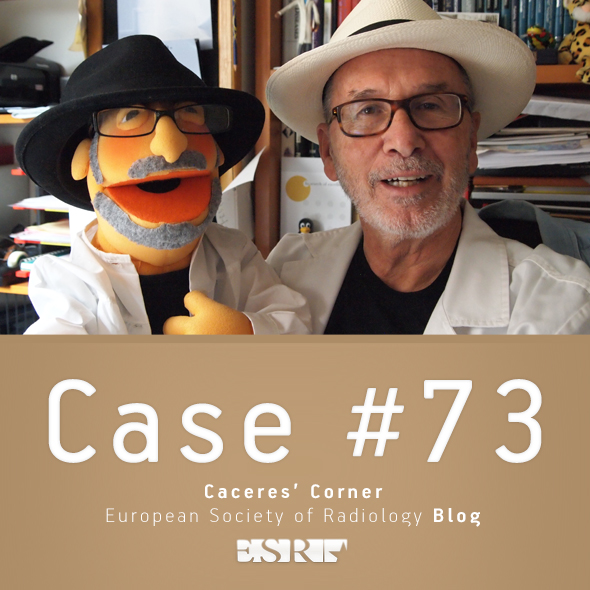
Dear Friends,
Presenting the last case before Summer vacation. Muppet needs quality time to replenish his energy (July and August) and will return in September with more interesting (and teaching) cases.
These radiographs belong to a 52-year-old male with a cough. The answer has now been added, but you can still leave your thoughts and diagnosis in the comments section, below, before you check it.
Diagnosis:
1. Mediastinal fat
2. Dilated SVC
3. Lymphoma
4. None of the above
Read more…
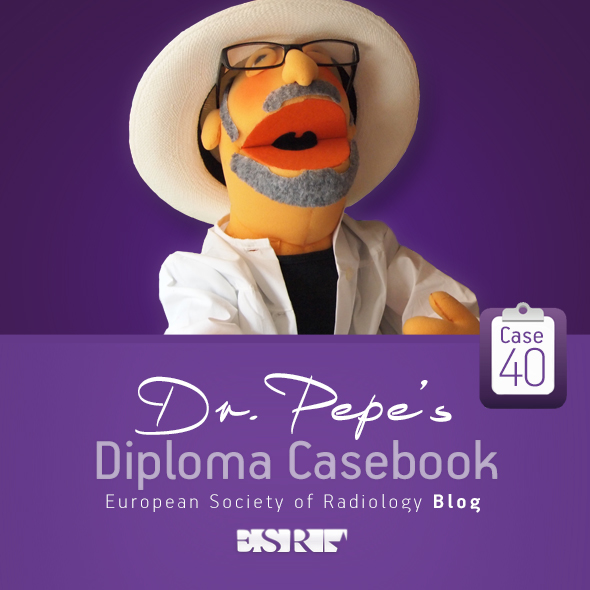
Dear Friends,
Showing you the last case before Summer vacation (July and August). Presenting radiographs of a 47-year-old man with moderate dyspnea.
Diagnosis:
1. Collapse of right lung
2. Right pneumonectomy
3. Congenital absence of right lung
4. None of the above
Read more…
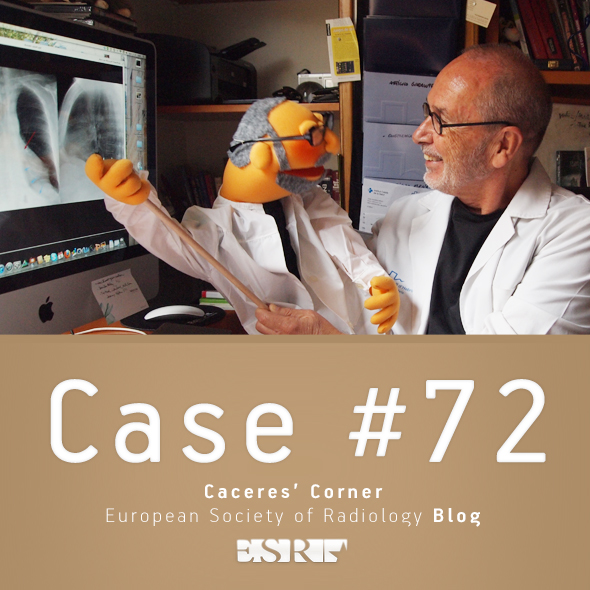
Dear friends,
Showing post-operative radiographs of a 34-year-old male. Muppet saw the films without clinical information and was completely lost.
Can you interpret the findings and shame Muppet into early retirement? Check out the images below, post your thoughts and possible diagnoses in the comments section, and come back next Tuesday for the answer!
Read more…
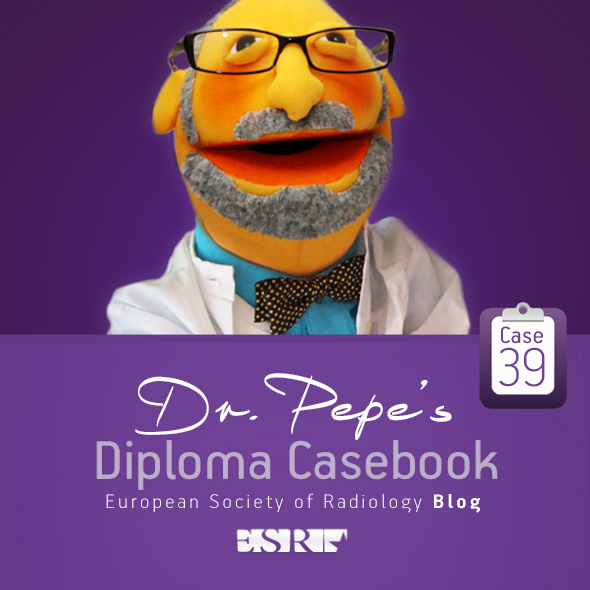 Dear friends,
Dear friends,
Presenting mammograms of a 45 y.o. woman with a palpable abnormality in the left breast.
Diagnosis:
1. Carcinoma
2. Fibroadenoma
3. Intrammamary lymph node
4. All of the above
Read more…
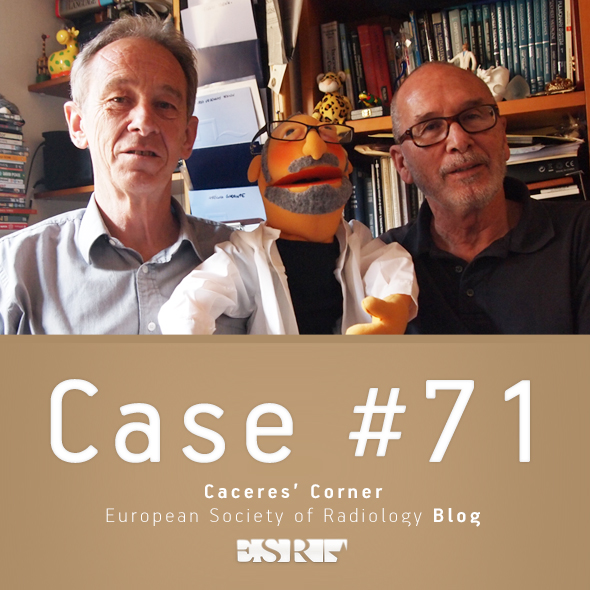
Dear Friends,
This week we’re presenting another case provided by my friend Jose Vilar: a 39-year-old woman with cough and moderate dyspnea.
Diagnosis:
1. Mediastinal fat
2. TB
3. LUL collapse
4. None of the above
Read more…









